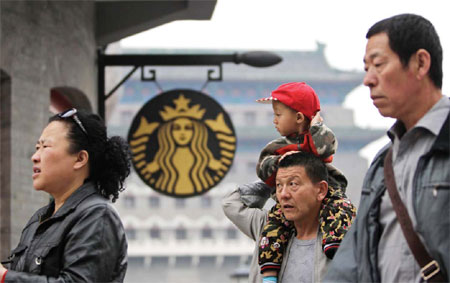Coffee break in tradition
Updated: 2012-10-12 08:51
By Lu Chang (China Daily)
|
|||||||||
|
A Starbucks sign is seen in Qianmen, Beijing. The increasing interest of the Chinese consumers for coffee has created huge opportunities for coffee chains and equipment makers. Jason Lee / Reuters |
At home and in cafes, China is waking up and smelling the coffee
When Diego Panucci left home for his first trip to China in 2000, there was one very important thing he forgot in his weeks of preparation - his coffee maker. The young Italian, who came to study Chinese, was facing a year without caffeine as precious few coffee shops existed in China back then, when the growing middle classes had yet to begin developing a taste for arabica and robusta beans.
"It was really killing me, and when I told the taxi driver to find a cafe, he didn't have the faintest idea what I was talking about," says Panucci, who can't begin a day without having his espresso. "I found instant coffee instead. It wasn't espresso but it was better than nothing."
|
||||
And Panucci no longer frets about his caffeine hits when he frequently visits the country through his job in event management.
From the proliferating coffee shops in the big cities to the coffee machines slowly infiltrating households, the home of tea is rapidly giving way to java, mocha, latte and the like.
In 2010, China's coffee consumption was estimated to be 25,000 tons, compared with more than one million tons of tea. But analysts from Barclays Capital forecast that the figure will grow by an average rate of almost 40 percent a year from 2011 to 2015.
"Currently the average coffee consumption in China stands at a mere three cups per person per year, while that figure rises to 240 cups for the world's average," says Ji Ming, chief of the Beijing Coffee Industry Association. "Therefore, there's a lot of growth potential in China's coffee market."
Analysts cite Japan where love of tea runs just as deep as in China, but with promotion of coffee, its per capita annual coffee consumption has already hit 300 cups, well above the global average.
"With the current growth rate, it is only a matter of time before China zooms past Japan as the second-largest coffee consumer in the world," Ji says.
However, compared with Japan, coffee drinking in China is more about seeking a Western lifestyle or is a social trend for many young urbanites, rather than a habit.
"In China, coffee is more like a symbol of Western affluence, friendship and a bridge in connecting the people," says Raymond Tong, CEO of Pacific Coffee, the second-largest coffee chain in Hong Kong after Starbucks, and now owned by the State-backed China Resources Vanguard.
"More and more people are embracing the practice of meeting over coffee, and group networking at coffee shops to discuss business or simply for pleasure," he says.
Huang Long, the 38-year-old owner of an IT company in Beijing, says he doesn't drink coffee when he visits a coffee shop as he hasn't got used to its bitterness. But he comes to Starbucks at least four times a week to surf the Internet or meet with friends.
"I like the environment of the coffee house," he says. "It is a relaxing place to chat, hang out, and even to work.
"Besides, sitting around a coffee house with a mug in hand is just a new lifestyle affectation."
Sentiments like these are exactly what coffee promoters like to hear, and explain why a wide array of companies are speeding up expansion to win a decent slice of China's coffee pie.
Currently, Seattle-based Starbucks operates more than 650 stores across 51 Chinese cities and takes the lion's share in the market of specialty coffee shops - more than half in terms of revenue, according to a Euromonitor research report in 2011 - and it plans to increase the number to 1,500 stores, across more than 70 cities and triple the number of employees to 30,000 by 2015.
- Troubles brew for coffee growers
- Yunnan seeks to associate itself with coffee production
- China joins coffee club
- Domestic coffee plan is brewing
- No coffee mourning over expensive drinks in Starbucks
- Coffee output in Yunnan grows by 11.33%
- Don't want to get depressed? Drink coffee
- Coffee outlets brew up a recipe for greater diversity
- Starbucks to launch JV with Chinese coffee-growing firm
- Coffee and cats, a purrfect combination
- Coffee maker Illy banks on China

 Relief reaches isolated village
Relief reaches isolated village
 Rainfall poses new threats to quake-hit region
Rainfall poses new threats to quake-hit region
 Funerals begin for Boston bombing victims
Funerals begin for Boston bombing victims
 Quake takeaway from China's Air Force
Quake takeaway from China's Air Force
 Obama celebrates young inventors at science fair
Obama celebrates young inventors at science fair
 Earth Day marked around the world
Earth Day marked around the world
 Volunteer team helping students find sense of normalcy
Volunteer team helping students find sense of normalcy
 Ethnic groups quick to join rescue efforts
Ethnic groups quick to join rescue efforts
Most Viewed
Editor's Picks

|

|

|

|

|

|
Today's Top News
Chinese fleet drives out Japan's boats from Diaoyu
Health new priority for quake zone
Inspired by Guan, more Chinese pick up golf
Russia criticizes US reports on human rights
China, ROK criticize visits to shrine
Sino-US shared interests emphasized
China 'aims to share its dream with world'
Chinese president appoints 5 new ambassadors
US Weekly

|

|











